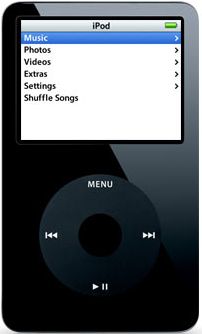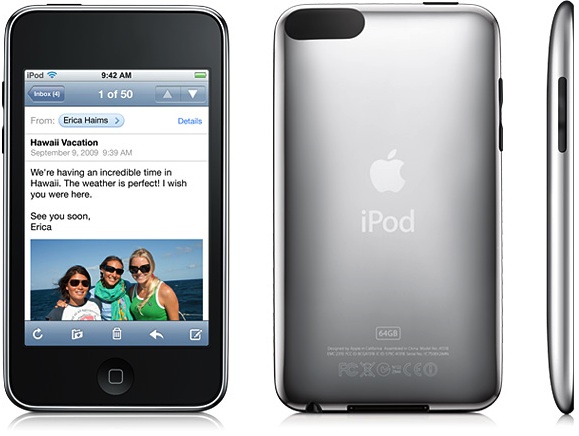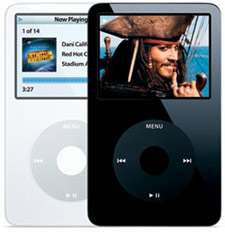To date, there have been six generations of the iPod, as well as a spin-off (the iPod Photo) that was later re-integrated into the main iPod line. (Some sources incorrectly refer to the revisions of the sixth generation as a separate "seventh generation.") All generations use a 1.8-inch (46 mm) hard drive for storage. The "classic" suffix was was initially introduced when a freelance writer analyzing eBay's used/broken iPod marketplace categorized iPods into different types on May 21, 2006 and was formally introduced with the introduction of the sixth-generation iPod on September 5, 2007 prior to this, all iPod models were simply referred to as iPods. It is available in silver or black replacing the "signature iPod white".
On March 20, 2002, Apple introduced a 10 GB model of the first generation iPod for US$499. vCard compatibility was added, as well, allowing iPods to display business card information synced from a Mac.
The second generation iPod was introduced on July 17, 2002. Using the same body style as the first generation, the hold switch was redesigned, a cover was added to the FireWire port, and the mechanical wheel was replaced with a touch-sensitive wheel. The front plate also had rounded corners and edges. The second-generation class was available in 10 GB for US$399 and 20 GB for US$499. The first-generation 5 GB iPod was carried over, but its price was reduced to US$299.
Notably, Apple began selling Windows-compatible versions of the iPod starting with the second generation. These versions came with a 4-pin to 6-pin FireWire adapter and were bundled with Musicmatch Jukebox instead of iTunes.
In December 2002, Apple unveiled its first limited edition iPods, with either Madonna's, Tony Hawk's, or Beck's signature or No Doubt's band logo engraved on the back for an extra US$50.
On April 29, 2003, Apple announced a completely redesigned third-generation iPod. Thinner than the previous models, the third generation models replaced the FireWire port with a new Dock Connector (which is still used today) and introduced the Touch Wheel, a completely non-mechanical interface with the four auxiliary buttons located in a row between the screen and the touch wheel. The front plate had rounded edges, and the rear casing was slightly rounded as well. A new wired remote connector was introduced. Whereas first and second generation iPods had an auxiliary ring around the headphone port for the remote, the third generation iPods had a 4-pin jack adjacent to the headphone port. A 10 GB model was sold for US$299, a 15 GB model for US$399, and a 30 GB model for US$499. All iPods were now compatible with Mac and Windows out of the box, simply requiring Windows users to reformat the iPod before use on a PC and both iTunes and Musicmatch were bundled with all iPods. The battery life was reduced to 8 hours, partially due to the use of a lithium-ion battery as opposed to a lithium polymer battery.
The 15 GB model was replaced by a 20 GB model and the 30 GB model was upgraded to 40 GB on September 8, 2003. The Windows-based Musicmatch software was made obsolete by and replaced by iTunes 4.1, the first version available for Microsoft Windows. Announced on July 19, 2004, the fourth-generation iPod replaced the touch wheel from the third generation iPod with the Click Wheel from the iPod Mini, putting the four auxiliary buttons underneath a touch-sensitive scroll wheel. The casing was also slightly slimmer. Pricing was reduced and the lineup was simplified, as the 20 GB model was sold for US$299 and the 40 GB model for US$399. Notably, Apple began reducing pack-in accessories starting with the fourth generation. While a dock, carrying case, and wired remote were previously included with higher-end iPods, the higher-level 40GB iPod only came with a dock, earphones and an interchangeable proprietary cable capable of USB and FireWire interface. In addition to using the iPod Mini's Click Wheel, the fourth generation iPod used the more energy-efficient components of the Mini, allowing the fourth generation iPod to over 12 hours of battery life while using the same battery as its predecessor. A special U2 edition was announced on October 26, 2004, to cross-market U2's How to Dismantle an Atomic Bomb album. The plastic front piece of the U2 edition iPod was black and the scroll wheel was red, to coincide with the color scheme of the U2 album. With 30 GB and the signatures of all four members of U2, the special edition iPod was priced at US$349 and also included a US$50 coupon for a US$149 collection of U2's entire back catalog. U2 iPods had special privileges, such as downloading songs for free.
On March 20, 2002, Apple introduced a 10 GB model of the first generation iPod for US$499. vCard compatibility was added, as well, allowing iPods to display business card information synced from a Mac.
The second generation iPod was introduced on July 17, 2002. Using the same body style as the first generation, the hold switch was redesigned, a cover was added to the FireWire port, and the mechanical wheel was replaced with a touch-sensitive wheel. The front plate also had rounded corners and edges. The second-generation class was available in 10 GB for US$399 and 20 GB for US$499. The first-generation 5 GB iPod was carried over, but its price was reduced to US$299.
 The iPod (5th generation) |  iPod touch (2nd generation) is |  iPod Classic (6th generation) |  [edit] Sixth generation |  Apple iPod Classic 30GB 5th |
 40GB Hard Drive IPod Classic |  iPod Classic - 5th Generation |  Apple iPod Classic 5th |  generation iPod classic |  Apple iPod Classic 60GB 5th |
On April 29, 2003, Apple announced a completely redesigned third-generation iPod. Thinner than the previous models, the third generation models replaced the FireWire port with a new Dock Connector (which is still used today) and introduced the Touch Wheel, a completely non-mechanical interface with the four auxiliary buttons located in a row between the screen and the touch wheel. The front plate had rounded edges, and the rear casing was slightly rounded as well. A new wired remote connector was introduced. Whereas first and second generation iPods had an auxiliary ring around the headphone port for the remote, the third generation iPods had a 4-pin jack adjacent to the headphone port. A 10 GB model was sold for US$299, a 15 GB model for US$399, and a 30 GB model for US$499. All iPods were now compatible with Mac and Windows out of the box, simply requiring Windows users to reformat the iPod before use on a PC and both iTunes and Musicmatch were bundled with all iPods. The battery life was reduced to 8 hours, partially due to the use of a lithium-ion battery as opposed to a lithium polymer battery.
 Great working iPod 5th Gen | Apple iPod classic 5th |  3D Model of Apple Ipod Classic |  [edit] First generation |  iPod Video 5th Gen |
 The 5G (5th generation) iPod |  Apple iPod Classic 80gb Black |  5th generation iPod |  Apple iPod Classic 5th |  Used iPod classic 5th |












No comments:
Post a Comment